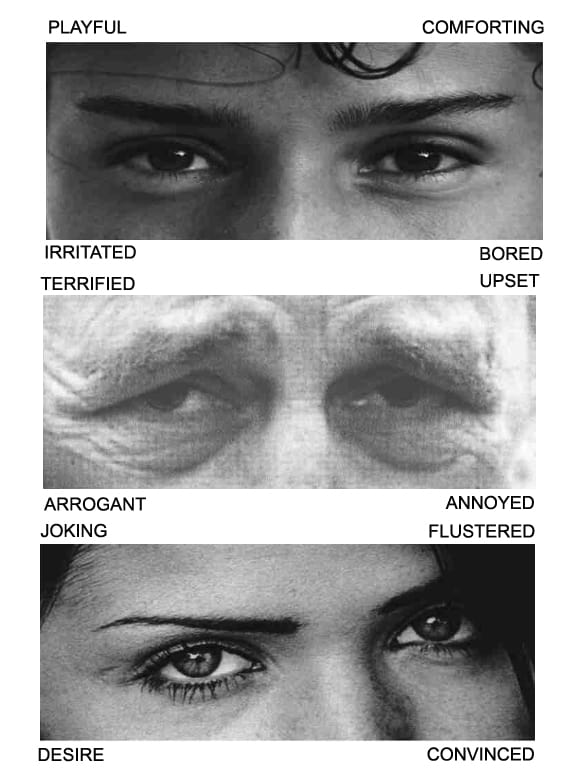I’ve recently been involved in advising a fascinating BBC television series called Child of Our Time about how to measure empathy. This long-term project involves tracking the lives and development of 25 children from a range of social and ethnic backgrounds born in 2000, over a period of twenty years. The children are now ten, and the series currently in production aims to unveil the influences that shape their varying personality traits.
One of the empathy tests we discussed is called Reading the Mind in the Eyes, created by the Cambridge psychologist Simon Baron-Cohen, an expert on autism and author of a controversial book called The Essential Difference, which argues that women are more naturally empathetic than men. The test effectively gauges how good you are at judging someone’s emotional state through looking at their eyes. You are presented with 36 sets of eyes, and for each of them you are instructed to choose which one of four words best describes what the person in the picture is thinking or feeling. Have a go at the initial three pairs of eyes in the test (the correct answers are at the end of this blog). The first offers a choice between ‘playful’, ‘comforting’, ‘irritated’ and ‘bored’:
It takes under five minutes to complete the whole test, which you can do here.
Most people are surprisingly good at this test, and a typical score ranges from 22 to 30 correct answers out of 36. Women, as Baron-Cohen has shown in several studies, score better than men on average, while those with the autism disorder Asperger’s syndrome tend to score lower than the typical man or woman.
But the real question is, how well does Reading the Mind in the Eyes measure empathy? I have to admit that I am fairly sceptical about the huge number of empathy tests that have been developed by psychologists over the past half century. The art of empathising seems far too complex to me to be easily reducible to a survey or lab experiment, no matter how ingeniously designed. Yet it is clear that some tests are better than others, and the virtue of Reading the Mind in the Eyes is that it gets away from the rather crass self-rating surveys which compile your answers to questions like, ‘On a scale of one to five, how good do you think you are at understanding when another person is upset’.
I do, however, have doubts about an empathy test based on interpreting what you can see in people’s eyes. I might, for instance, be able to identify that somebody is upset by the expression around their eyes, but this does not mean I necessarily understanding anything about why they are upset – I haven’t really stepped into their shoes (which is an essential feature of what is known as ‘cognitive empathy’). Nor does my visual recognition imply that I have made any emotional connection with them or formed any kind of human bond (which are characteristics of ‘affective empathy’). I also wonder about the extent to which Reading the Mind in the Eyes is effective across cultures. When I lived for a time with indigenous Mayan refugees in the Guatemalan jungle, I found it incredibly difficult to read their facial expressions. One moment their eyes seemed impassive, even sad, then a second later – to my complete surprise – the person would burst out laughing. As far as I can see, Baron-Cohen’s test contains mostly Caucasian eyes – but a wider cultural variety might yield very different results. A final thought is that it is not obvious to me what really constitutes a ‘correct’ answer. Who has determined if the first set of eyes above are, say, ‘playful’ rather than ‘comforting’? And do our eyes only display one emotional trait at a time?
Despite my scepticism, I believe it can be useful to do such tests. In my view, they should not be taken to reveal any definitive truths about the kind of person you are, but should be simply seen as a way to raise interesting hypotheses about your character. If you happen to achieve a perfect score of 36, this does not mean you are an empathetic mastermind, but it might make you contemplate – and possibly doubt – whether you really are as empathetic as the test indicates. The numerical results of any test concerning the human condition must be taken not as a final conclusion, but as the beginning of a deeper inquiry.
Answers to Reading the Mind in the Eyes test: 1. playful; 2. upset; 3. desire.

Are they eyes truly the windows to the soul? Do I need to see to feel empathy for another? I am all for empathy and acknowledgement. In fact, it is hugely important to me and find it far easier to mirror another’s feelings and understanding by being “with” them, or at least somewhat present. What does it say that we can do this just from looking at a 2 dimensional photo of someone’s eyes?
Interesting thoughts Peter. Made me think about a blind friend of mine who is one of the most empathic people I know.